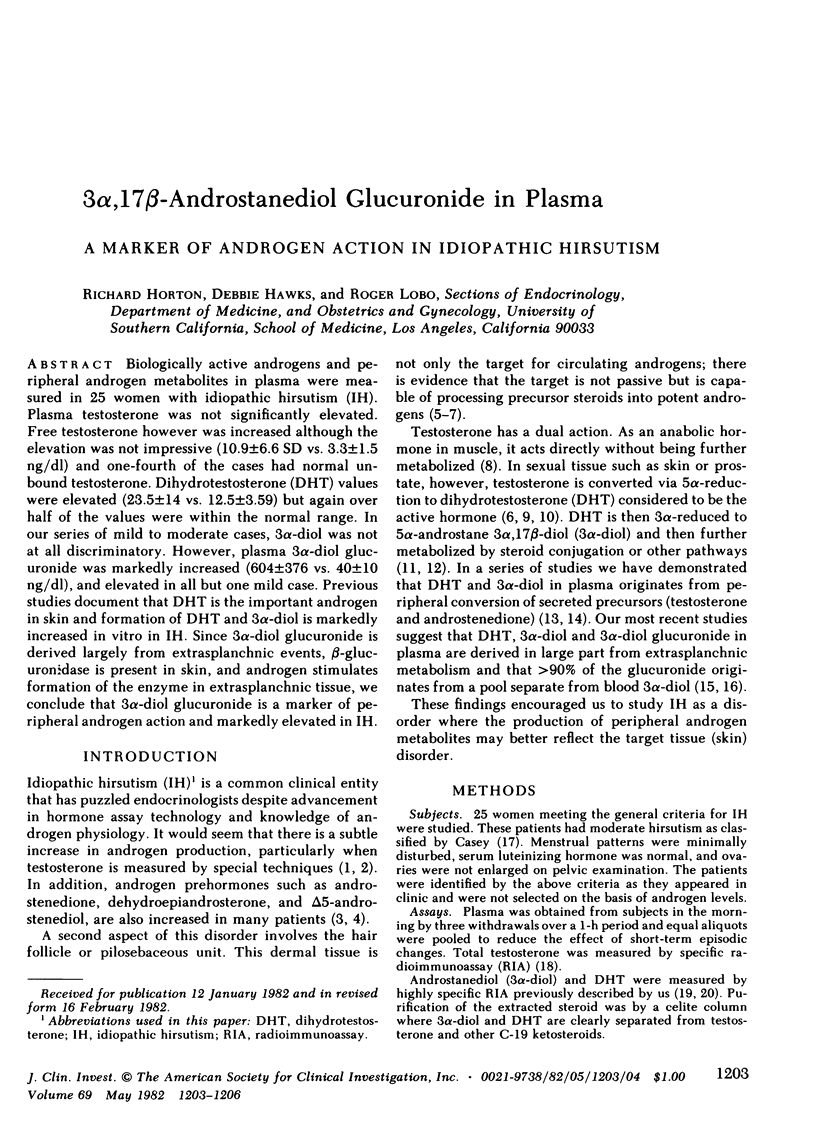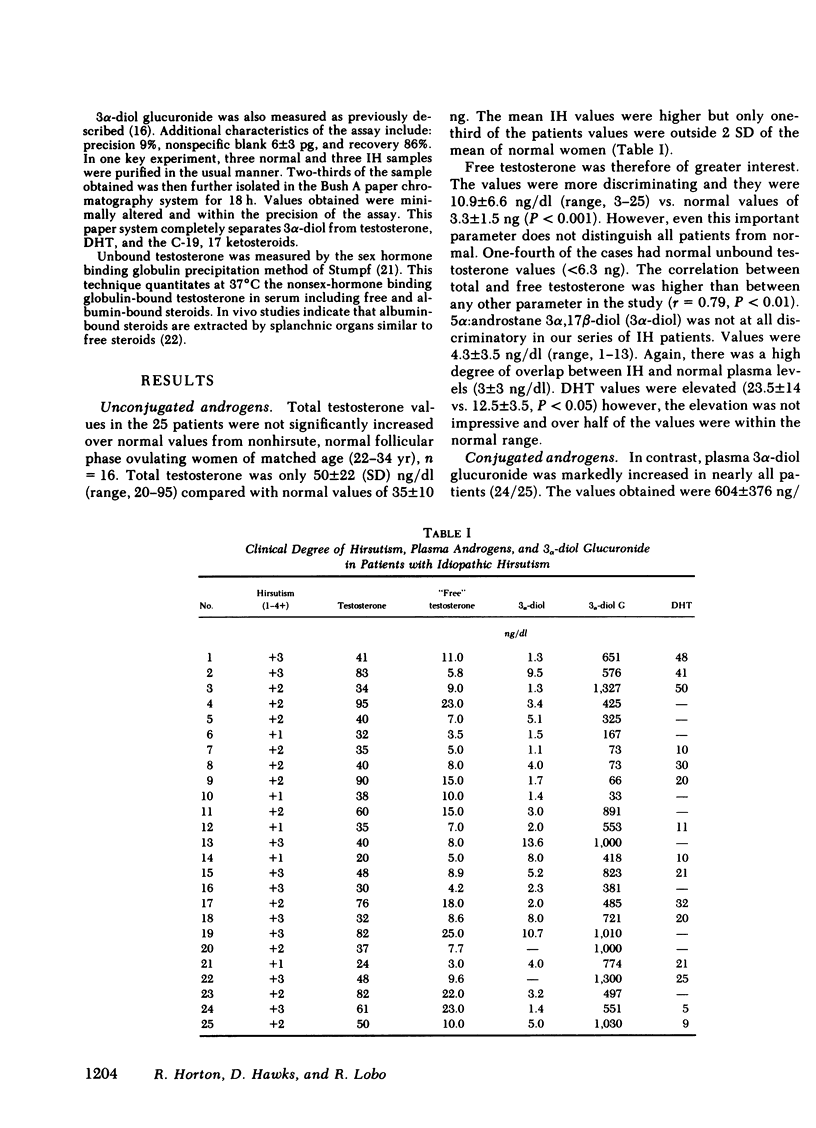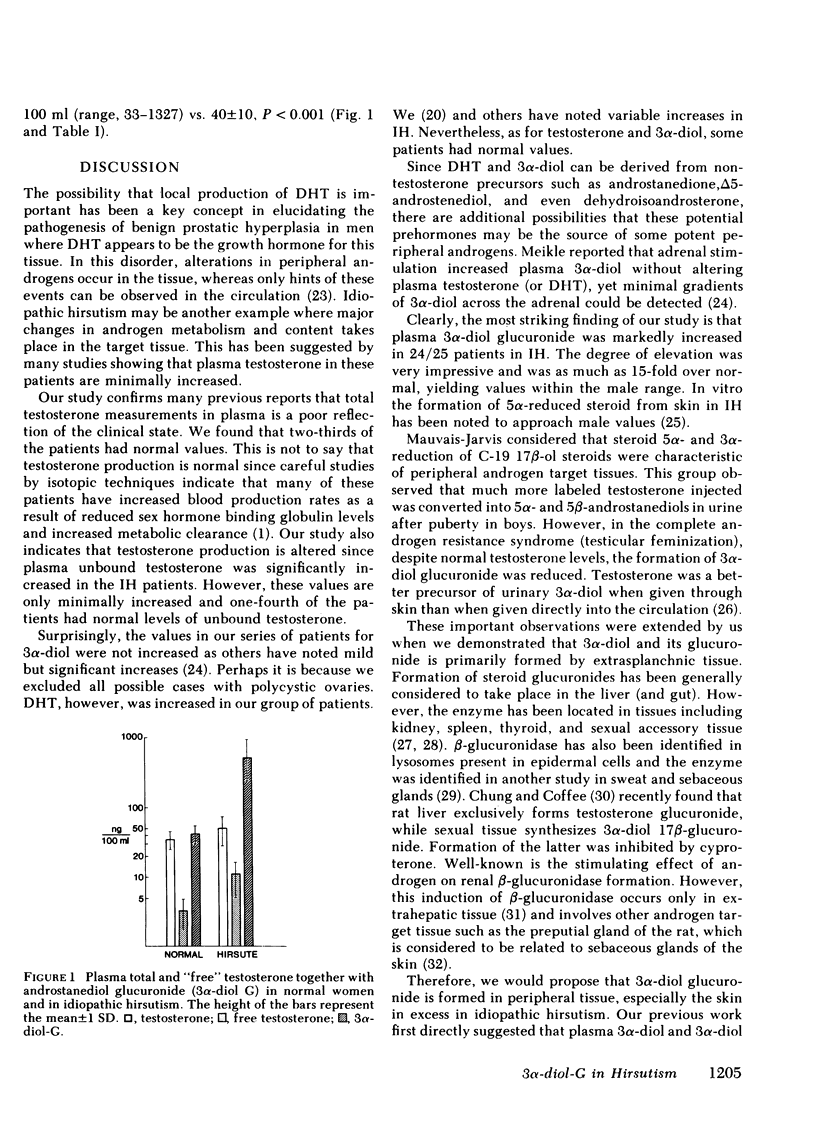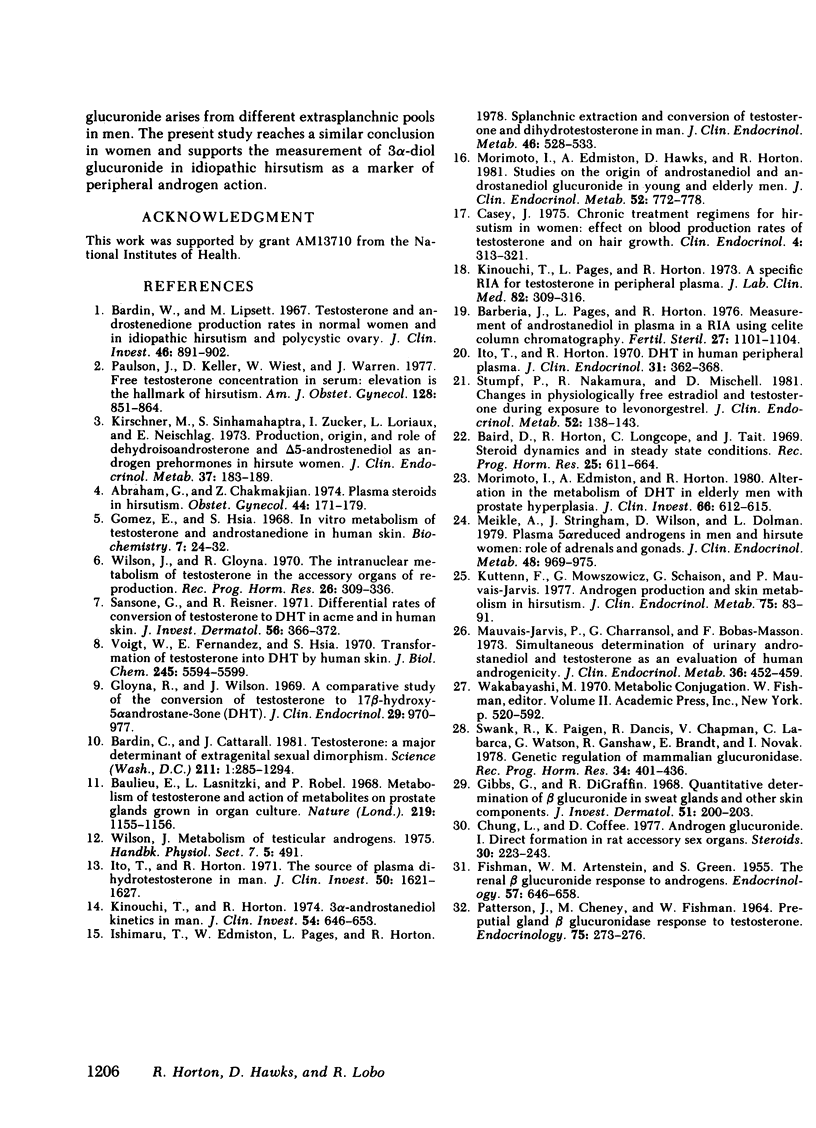Abstract
Biologically active androgens and peripheral androgen metabolites in plasma were measured in 25 women with idiopathic hirsutism (IH). Plasma testosterone was not significantly elevated. Free testosterone however was increased although the elevation was not impressive (10.9 +/- 6.6 SD vs. 3.3 +/- 1.5 ng/dl) and one-fourth of the cases had normal unbound testosterone. Dihydrotestosterone (DHT) values were elevated (23.5 +/- 14 vs. 12.5 +/- 3.59) but again over half of the values were within the normal range. In our series of mild to moderate cases, 3 alpha-diol was not at all discriminatory. However, plasma 3 alpha-diol glucuronide was markedly increased (604 +/- 376 vs. 40 +/- 10 ng/dl), and elevated in all but one mild case. Previous studies document that DHT is the important androgen in skin and formation of DHT and 3 alpha-diol is markedly increased in vitro in IH. Since 3 alpha-diol glucuronide is derived largely from extrasplanchnic events, beta-glucuronidase is present in skin, and androgen stimulates formation of the enzyme in extrasplanchnic tissue, we conclude that 3 alpha-diol glucuronide is a marker of peripheral androgen action and markedly elevated in IH.
Full text
PDF



Selected References
These references are in PubMed. This may not be the complete list of references from this article.
- Abraham G. E., Chakmakjian Z. H. Plasma steroids in hirsutism. Obstet Gynecol. 1974 Aug;44(2):171–175. [PubMed] [Google Scholar]
- Baird D. T., Horton R., Longcope C., Tait J. F. Steroid dynamics under steady-state conditions. Recent Prog Horm Res. 1969;25:611–664. doi: 10.1016/b978-0-12-571125-8.50017-x. [DOI] [PubMed] [Google Scholar]
- Barberia J., Pages L., Horton R. Measurement of androstanediol in plasma in a radioimmunoassay using celite column chromatography. Fertil Steril. 1976 Sep;27(9):1101–1104. doi: 10.1016/s0015-0282(16)42081-9. [DOI] [PubMed] [Google Scholar]
- Bardin C. W., Catterall J. F. Testosterone: a major determinant of extragenital sexual dimorphism. Science. 1981 Mar 20;211(4488):1285–1294. doi: 10.1126/science.7010603. [DOI] [PubMed] [Google Scholar]
- Bardin C. W., Lipsett M. B. Testosterone and androstenedione blood production rates in normal women and women with idiopathic hirsutism or polycystic ovaries. J Clin Invest. 1967 May;46(5):891–902. doi: 10.1172/JCI105588. [DOI] [PMC free article] [PubMed] [Google Scholar]
- Baulieu E. E., Lasnizki I., Robel P. Metabolism of testosterone and action of metabolites on prostate glands grown in organ culture. Nature. 1968 Sep 14;219(5159):1155–1156. doi: 10.1038/2191155a0. [DOI] [PubMed] [Google Scholar]
- Casey J. H. Chronic treatment regimens for hirsutism in women: effect on blood production rates of testosterone and on hair growth. Clin Endocrinol (Oxf) 1975 May;4(3):313–325. doi: 10.1111/j.1365-2265.1975.tb01539.x. [DOI] [PubMed] [Google Scholar]
- Chung L. W., Coffey D. S. Androgen glucuronides. I. Direct formation in rat accessory sex organs. Steroids. 1977 Aug;30(2):223–243. doi: 10.1016/0039-128x(77)90084-8. [DOI] [PubMed] [Google Scholar]
- FISHMAN W. H., ARTENSTEIN M., GREEN S. The renal beta-glucuronidase response to androgens. Endocrinology. 1955 Dec;57(6):646–657. doi: 10.1210/endo-57-6-646. [DOI] [PubMed] [Google Scholar]
- Gibbs G. E., Friffin G. D. Quantitative determination of beta-glucuronidase in sweat gland and other skin components in cystic fibrosis. J Invest Dermatol. 1968 Sep;51(3):200–203. doi: 10.1038/jid.1968.115. [DOI] [PubMed] [Google Scholar]
- Gloyna R. E., Wilson J. D. A comparative study of the conversion of testosterone to 17-beta-hydroxy-5-alpha-androstan-3-one (Dihydrotestosterone) by prostate and epididymis. J Clin Endocrinol Metab. 1969 Jul;29(7):970–977. doi: 10.1210/jcem-29-7-970. [DOI] [PubMed] [Google Scholar]
- Gomez E. C., Hsia S. L. In vitro metabolism of testosterone-4-14C and delta-4-androstene-3,17-dione-4-14C in human skin. Biochemistry. 1968 Jan;7(1):24–32. doi: 10.1021/bi00841a004. [DOI] [PubMed] [Google Scholar]
- Ishimaru T., Edmiston W. A., Pages L., Horton R. Splanchnic extraction and conversion of testosterone and dihydrotestosterone in man. J Clin Endocrinol Metab. 1978 Apr;46(4):528–533. doi: 10.1210/jcem-46-4-528. [DOI] [PubMed] [Google Scholar]
- Ito T., Horton R. Dihydrotestosterone in human peripheral plasma. J Clin Endocrinol Metab. 1970 Oct;31(4):362–368. doi: 10.1210/jcem-31-4-362. [DOI] [PubMed] [Google Scholar]
- Ito T., Horton R. The source of plasma dihydrotestosterone in man. J Clin Invest. 1971 Aug;50(8):1621–1627. doi: 10.1172/JCI106650. [DOI] [PMC free article] [PubMed] [Google Scholar]
- Kinouchi T., Horton R. 3Alpha-androstanediol kinetics in man. J Clin Invest. 1974 Sep;54(3):646–653. doi: 10.1172/JCI107802. [DOI] [PMC free article] [PubMed] [Google Scholar]
- Kinouchi T., Pages L., Horton R. A specific radioimmunossay for testosterone in peripheral plasma. J Lab Clin Med. 1973 Aug;82(2):309–316. [PubMed] [Google Scholar]
- Kirschner M. A., Sinhamahapatra S., Zucker I. R., Loriaux L., Nieschiag E. The production, origin and role of dehydroepiandrosterone and delta 5-androstenediol as androgen prehormones in hirsute women. J Clin Endocrinol Metab. 1973 Aug;37(2):183–189. doi: 10.1210/jcem-37-2-183. [DOI] [PubMed] [Google Scholar]
- Kuttenn F., Mowszowicz I., Schaison G., Mauvais-Jarvis P. Androgen production and skin metabolism in hirsutism. J Endocrinol. 1977 Oct;75(1):83–91. doi: 10.1677/joe.0.0750083. [DOI] [PubMed] [Google Scholar]
- Mauvais-Jarvis P., Charransol G., Bobas-Masson F. Simultaneous determination of urinary androstanediol and testosterone as an evaluation of human androgenicity. J Clin Endocrinol Metab. 1973 Mar;36(3):452–459. doi: 10.1210/jcem-36-3-452. [DOI] [PubMed] [Google Scholar]
- Meikle A. W., Stringham J. D., Wilson D. E., Dolman L. I. Plasma 5 alpha-reduced androgens in men and hirsute women: role of adrenals and gonads. J Clin Endocrinol Metab. 1979 Jun;48(6):969–975. doi: 10.1210/jcem-48-6-969. [DOI] [PubMed] [Google Scholar]
- Morimoto I., Edmiston A., Hawks D., Horton R. Studies on the origin of androstanediol and androstanediol glucuronide in young and elderly men. J Clin Endocrinol Metab. 1981 Apr;52(4):772–778. doi: 10.1210/jcem-52-4-772. [DOI] [PubMed] [Google Scholar]
- Morimoto I., Edmiston A., Horton R. Alteration in the metabolism of dihydrotestosterone in elderly men with prostate hyperplasia. J Clin Invest. 1980 Sep;66(3):612–615. doi: 10.1172/JCI109895. [DOI] [PMC free article] [PubMed] [Google Scholar]
- PATTERSON J. F., CHENEY M., FISHMAN W. H. PREPUTIAL GLAND BETA-GLUCURONIDASE RESPONSE TO TESTOSTERONE AND TO TWO ANABOLIC STEROIDS. Endocrinology. 1964 Aug;75:273–276. doi: 10.1210/endo-75-2-273. [DOI] [PubMed] [Google Scholar]
- Paulson J. D., Keller D. W., Wiest W. G., Warren J. C. Free testosterone concentration in serum: elevation is the hallmark of hirsutism. Am J Obstet Gynecol. 1977 Aug 15;128(8):851–857. doi: 10.1016/0002-9378(77)90052-7. [DOI] [PubMed] [Google Scholar]
- Sansone G., Reisner R. M. Differential rates of conversion of testosterone to dihydrotestosterone in acne and in normal human skin--a possible pathogenic factor in acne. J Invest Dermatol. 1971 May;56(5):366–372. doi: 10.1111/1523-1747.ep12261252. [DOI] [PubMed] [Google Scholar]
- Stumpf P. G., Nakamura R. M., Mishell D. R., Jr Changes in physiologically free circulating estradiol and testosterone during exposure to levonorgestrel. J Clin Endocrinol Metab. 1981 Jan;52(1):138–143. doi: 10.1210/jcem-52-1-138. [DOI] [PubMed] [Google Scholar]
- Swank R. T., Paigen K., Davey R., Chapman V., Labarca C., Watson G., Ganschow R., Brandt E. J., Novak E. Genetic regulation of mammalian glucuronidase. Recent Prog Horm Res. 1978;34:401–436. doi: 10.1016/b978-0-12-571134-0.50015-6. [DOI] [PubMed] [Google Scholar]
- Voigt W., Fernandez E. P., Hsia S. L. Transformation of testosterone into 17 beta-hydroxy-5 alpha-androstan-3-one by microsomal preparations of human skin. J Biol Chem. 1970 Nov 10;245(21):5594–5599. [PubMed] [Google Scholar]
- Wilson J. D., Gloyna R. E. The intranuclear metabolism of testosterone in the accessory organs of reproduction. Recent Prog Horm Res. 1970;26:309–336. doi: 10.1016/b978-0-12-571126-5.50012-1. [DOI] [PubMed] [Google Scholar]


